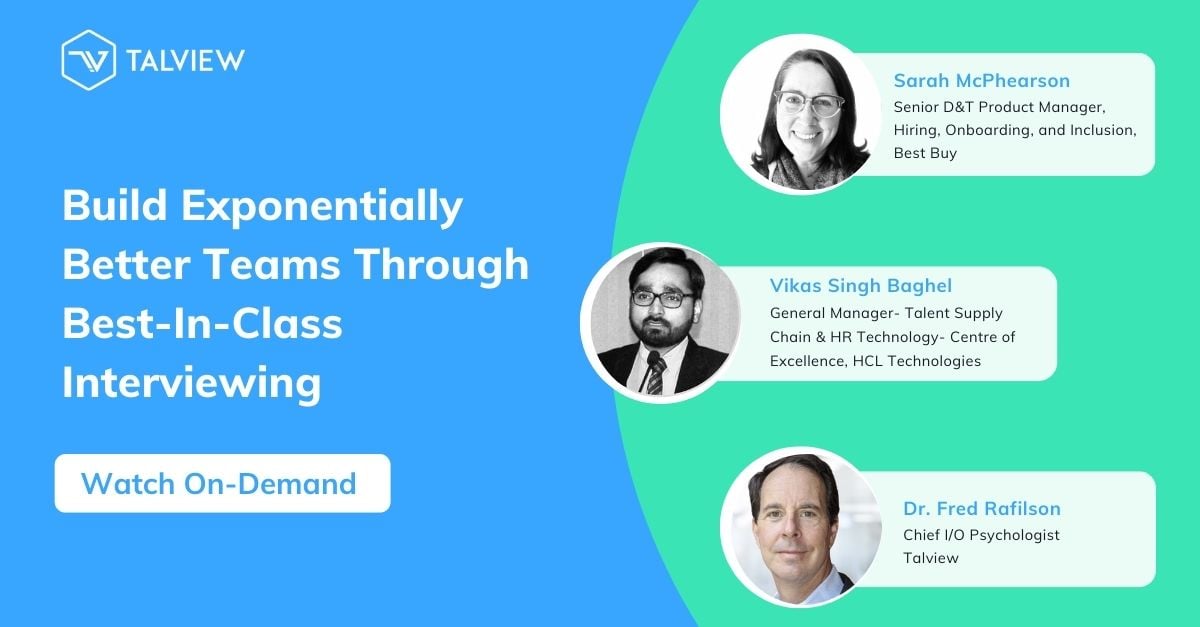Building Better Teams via Best-In-Class Interviewing
Interviewing has long been a blind spot in the hiring process. How do you accurately predict a candidate’s performance if you can’t measure and ensure the quality of their interview process and their interviewer? How do you do that at an enterprise scale?
Organizations define candidate measurement and experience protocols in hiring, but have struggled to identify effective interview frameworks. The interview is the most common, essential component of recruiting and talent acquisition. But the lack of standardization in interview processes have dramatically decreased the fairness, clarity, and confidence in talent decisions at organizations and businesses of all sizes.
Most interviewers have little to no training in conducting a quality interview. There hasn’t been any way to monitor or efficiently review techniques or the interviewer’s performance and effectiveness. This inability to control the quality of the interview process results in:
- Interviews not providing valid analysis, increasing the risk of bad hires
- Interviews that are not fair or unbiased, adversely impacting DEI goals
- Good candidates being lost to unskilled interviewers due to a poor candidate experience
Maximizing the Effectiveness of the Interview
Talview attended the HR Technology and Expo in Las Vegas, NV. While there, we sponsored a session, Build Exponentially Better Teams Through Best-In-Class Interviewing, and recorded it. It is now available on-demand for your convenience.
Session presented by:
- Dr. Fred Rafilson, Chief I/O Psychologist, Talview
- Sarah McPherson, SPHR CSPO, Best Buy
- Vikas Baghel, HCL
Excerpts from the Session
Recorded at HR Technology Conference & Exposition, Las Vegas, NV.
Where Interviews Go Wrong
“We talk a lot about assessments, candidate assessments, and we put a lot of focus on assessments, but the most widely used assessment of all gets the least amount of scrutiny, and that's the interview.
“Recruiters spend roughly about 6 seconds to decide whether a resume is going in the YES pile or the NO pile. Just the six seconds.”
In the interview process, there's so much focus on the candidate, but no one's looking at the interviewer. From listening to our customers and clients, the lack of skilled interviewers is a huge problem, a big blind spot in the hiring process. Enter the validity of interviews. In other words, how well interviews predict work. The quality of the interview is based not just on the questions asked, but on the interviewer's skills.
Interviewers are not always effective, resulting in bad hires. Interviewers are not always fair. No matter how hard we try, and how well-intentioned we are, we're all human beings and we have unconscious biases that creep into the interview. So it's this lack of interviewing skill and the resources to improve that really are the focus.”
Conversation is the Goal
“Start with a greeting. Hey, glad you're here. Talk about the importance of the position. I don't care if it's a warehouse role. If we can't get products off our shelves, we're out of business. So this is an important role for our organization. We’re interested in hearing about your experience and your thoughts. Describing the role, describing the company. Here's our values. This is who we are. This is why we're in business.
“Conduct the interview as a conversation, not an interrogation.”
Conduct the interview as a conversation, not an interrogation. It’s my biggest pet peeve for an interview. One that's an interrogation, because what kind of information are you going to get in an interrogation?”
Interviewing at Enterprise Scale
“I work at Best Buy. On average, we probably have 3 to 4000 people participate in interview processes for us every year, with 3 to 4000 different interviewers. We have over 100 stores. If those stores each have two people interviewing, that's 2000 interviewers. There is no possible way we as a company can train, monitor, give feedback ongoing to those people who are making talent decisions for our organization every day.
So I think looking at a tool like this [Talview Interview Insights], it gives us the ability to help those people who don't interview full-time for their roles. It's just an aspect of their job that become better. Build a skill and build a skill that ultimately will transform the performance of their retail location, which I think is Super Key.”
Interviewing is a Time Investment
“Recruiters spend roughly about 6 seconds to decide whether a resume is going in the YES pile or the NO pile. Just the six seconds. I think we take 30 times more to put our popcorn in our microwave, right? Imagine they're deciding your career in that six seconds.
Research says that at any given point in time, we are bombarded with 11 million topics of information. Our ability is to consume only 40. Now what will your brain do? It will look for shortcuts to arrive to a decision right when there is so much information available. Naturally, the brain will look for shortcuts to arrive at a decision.
“If I'm good at my job, by default, I become an interviewer irrespective of my interviewing skills.”
That's where unconscious bias comes in. The biases. Typical biases are race and gender. These are the obvious ones, but there are so many others which we are not aware of. All of us are biased in some shape and form.
Interviewing as a skill is taken for granted. If I'm good at my job, by default, I become an interviewer irrespective of my interviewing skills. I look for a best performer in my team and I say, hey, I'm trying to hire new talent, why don't you go interview some candidates. I don't know how good or bad he or she is as an interviewer. If they’re not skilled interviewers, you end up with bad hires, biases, and a poor candidate experience. The person is great at doing their job, but now they’re doing a role that they weren't trained for.”
Watch the complete session, On-Demand.








Leave a Reply